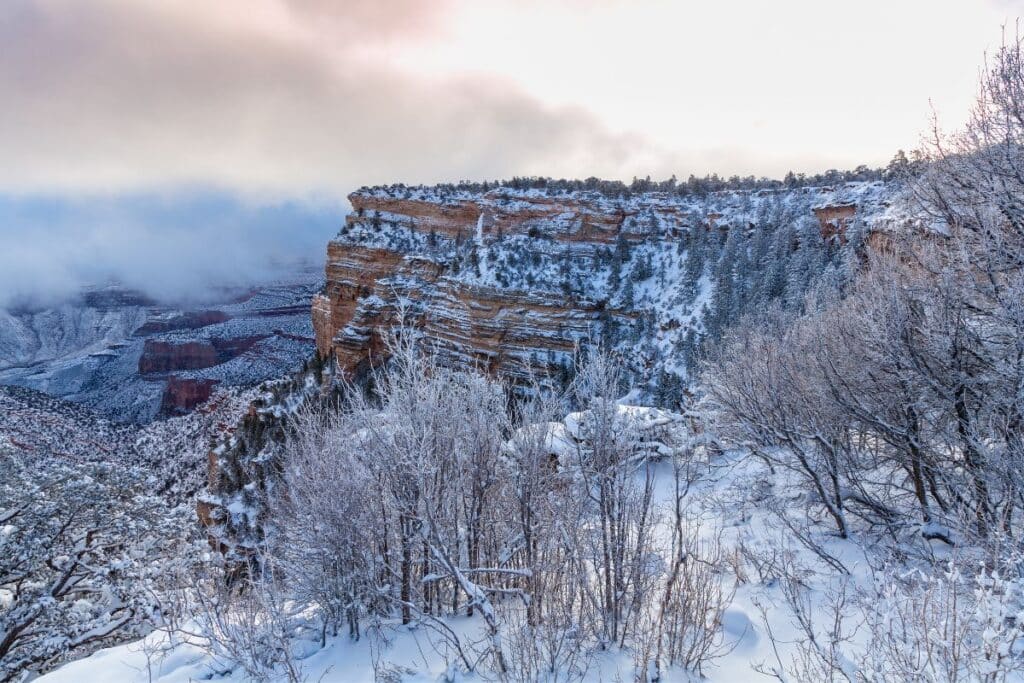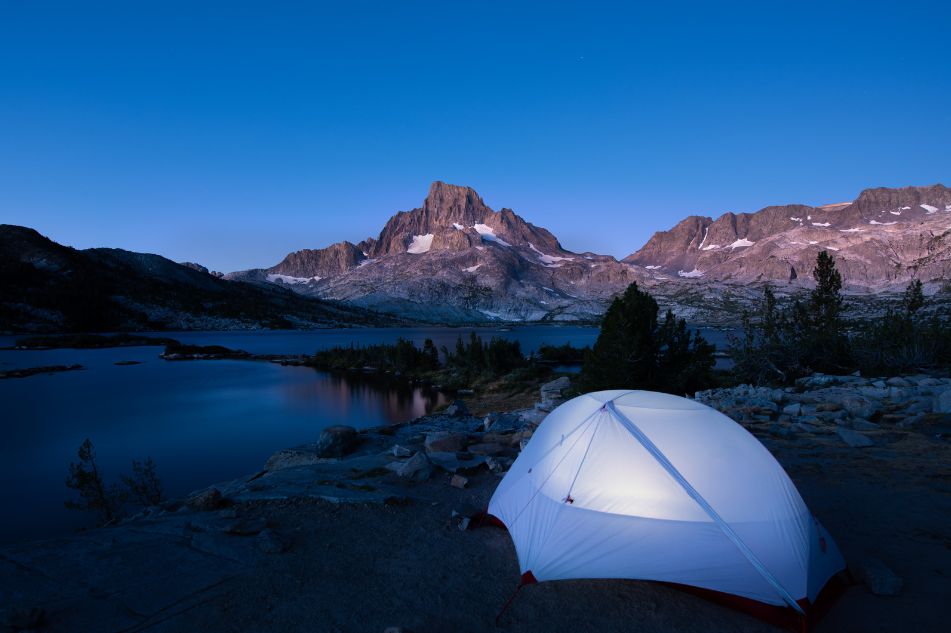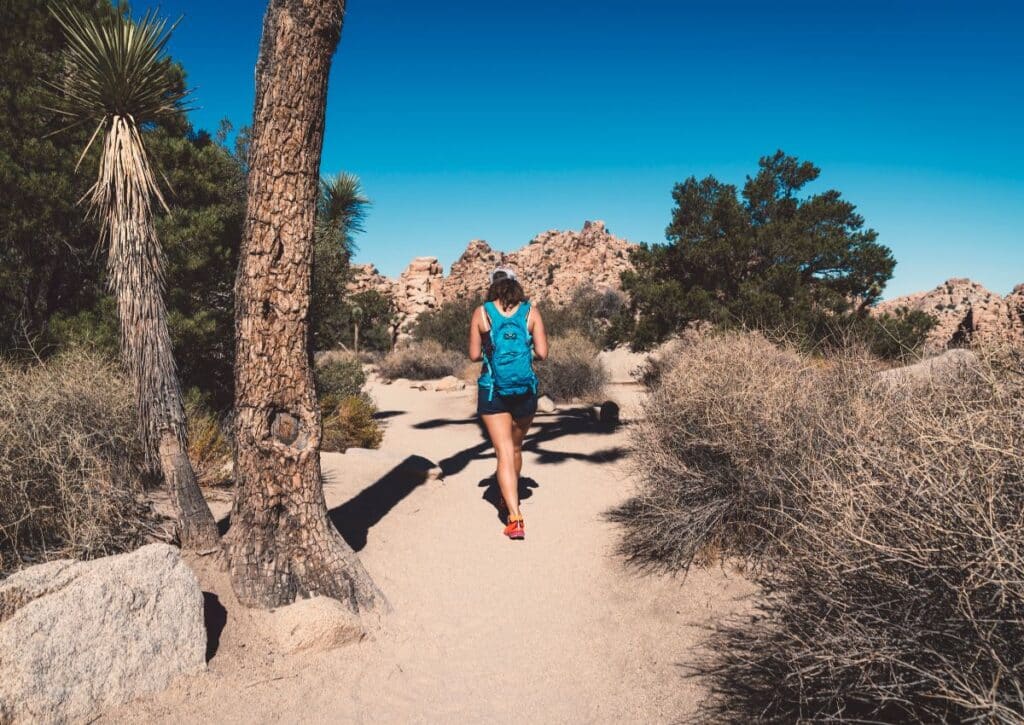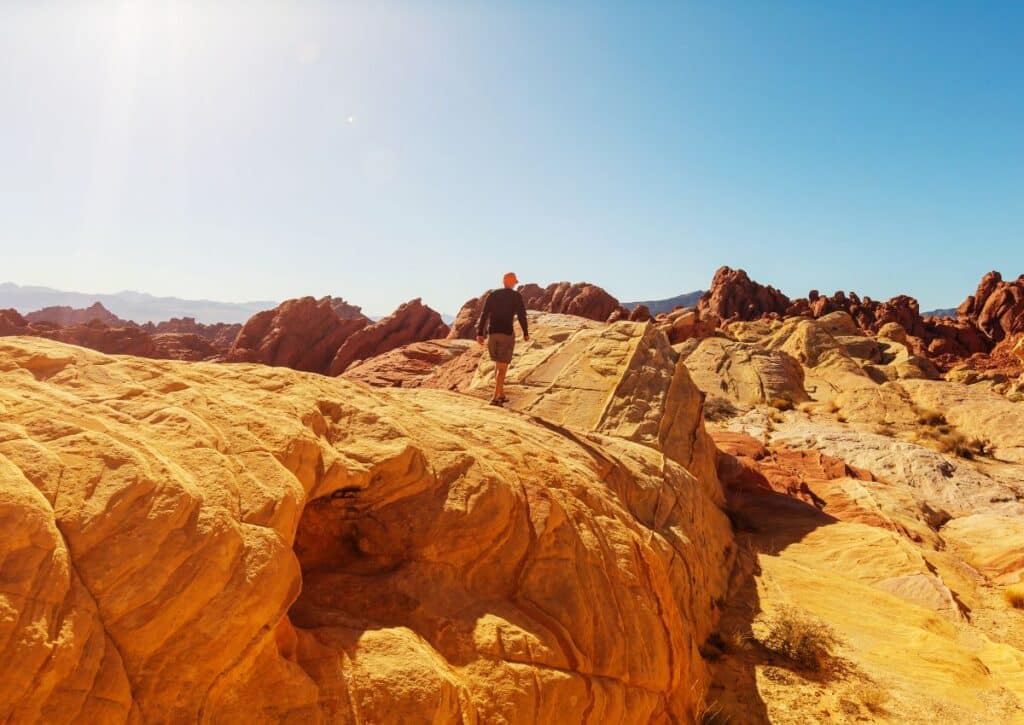Explore top winter things to do in Grand Canyon National Park: snow hikes, serene views, and unique adventures in a frosty wonderland.
Winter in the Grand Canyon is a secret waiting to be discovered. Far from the bustling crowds and scorching sun of summer, this iconic landscape wraps itself in a quiet blanket of snow, revealing a side that few have witnessed.
Picture towering cliffs dusted with frost, trails echoing with the crunch of fresh snow underfoot, and the serene beauty of the canyon walls bathed in soft winter light.
In this article, we’re about to unwrap the lesser-known joys of the Grand Canyon in its winter attire. From peaceful hikes on snow-capped paths to the enchanting glow of sunrise over icy rims, every moment here is a winter wonderland experience.
So, snuggle up in your favorite winter gear, and let’s embark on a journey through the Grand Canyon’s winter magic. Ready to see this natural wonder in a whole new light? Let’s dive in!
Hiking the South Rim Trail
Alright, let’s dive into some cool details about winter hiking at the Grand Canyon, specifically the South Rim Trail. It’s a whole different game in winter, and here’s the scoop:

For starters, you’ve got options. The Bright Angel Trail and South Kaibab Trail are the stars here. Bright Angel is about 12 miles round trip – a decent challenge with some amazing views. If you’re looking for something a bit shorter, South Kaibab is about 6 miles round trip, and oh boy, the panoramas are something else!
Now, packing is key. You’ll want layers – it’s cool in the mornings but can warm up. Good hiking boots are a must (watch out for icy patches). Gloves and a hat? Absolutely. And even though it’s chilly, don’t skimp on water and snacks. Hydration is still king.
Timing’s pretty important too. An early start gives you the best light for those jaw-dropping views, plus you’ll skip the bulk of the day-trippers. And if you can catch a sunrise or sunset, it’s like the canyon’s showing off just for you.
So, yeah, winter hiking at the South Rim is an epic experience – a bit of planning, the right gear, and you’re all set for a memorable adventure!
Visit the Yavapai Geology Museum
First off, the Yavapai Museum gives you this cozy, educational escape from the cold. Inside, you’re treated to these incredible panoramic windows. Imagine looking out at the snow-covered canyon while staying all warm and toasty. It’s like having a front-row seat to nature’s masterpiece, with the comfort of being indoors.
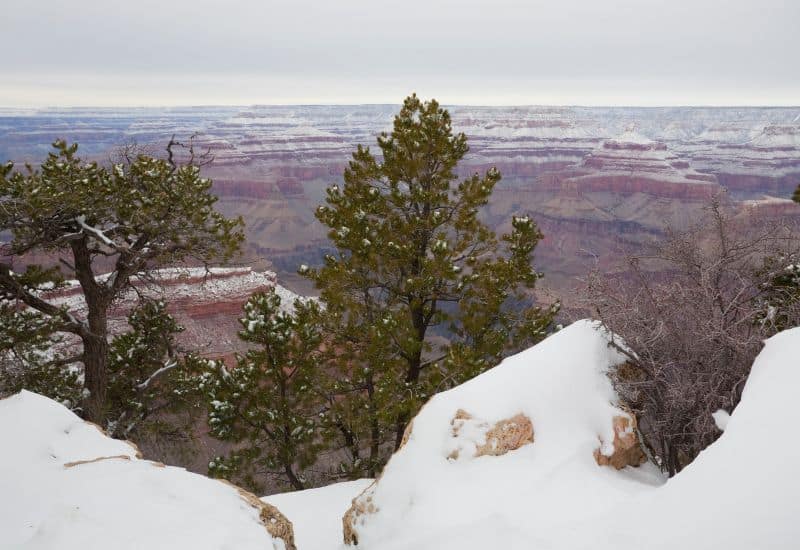
The museum itself? It’s packed with cool exhibits that explain the canyon’s geological history. You’ll see detailed displays, models, and loads of info about how the Grand Canyon came to be. It’s pretty fascinating to learn about all the layers and rock formations while actually seeing them right outside the window.
And here’s a fun part – they often have rangers giving talks and answering questions. So, if you’re curious about anything canyon-related, this is your chance to ask the experts.
Visiting the Yavapai Geology Museum is a perfect mix of education and awe-inspiring views, making it a must-do, especially on those chillier winter days in the Grand Canyon.
Photography at Hopi Point
When it comes to capturing the Grand Canyon’s winter beauty, Hopi Point is your golden ticket. This spot is a photographer’s dream, especially in the colder months.
So, why Hopi Point? Well, it’s all about the views and angles. You get a whopping 180-degree panorama of the canyon. We’re talking about views stretching from the east to the west, offering a diverse range of photo ops. The Colorado River? You can see it winding below, and in winter, the contrast with the snow is just stunning.
Now, let’s talk timing. For photographers, the magic hours are key. At Hopi Point, sunrise and sunset offer dramatically different lighting conditions. During sunrise, you get this soft, golden light illuminating the canyon. Sunset? It’s all about the vibrant, fiery hues reflecting off the rocks and snow. And here’s a number for you: Hopi Point is about 6,800 feet in elevation, so you’re high enough to get those breathtaking, wide-ranging shots.
But wait, there’s more. Winter means fewer tourists, so you’ve got a better chance of snagging those pristine, undisturbed shots. Plus, the winter air is usually clearer, giving you sharper, more vivid photos.
Remember, pack extra batteries (they drain faster in the cold) and keep your camera protected from the elements. Hopi Point in winter is not just a photography session; it’s an adventure capturing the Grand Canyon’s majestic beauty.
Wildlife Watching
Wildlife watching in the Grand Canyon during winter? It’s a whole different ball game, and here’s why it’s awesome:
First off, the cold weather means fewer people and more active wildlife. You’ve got a better chance of seeing animals like mule deer, elk, and bighorn sheep. These guys are more visible against the snowy backdrop, and with less human traffic, they’re out and about more often.
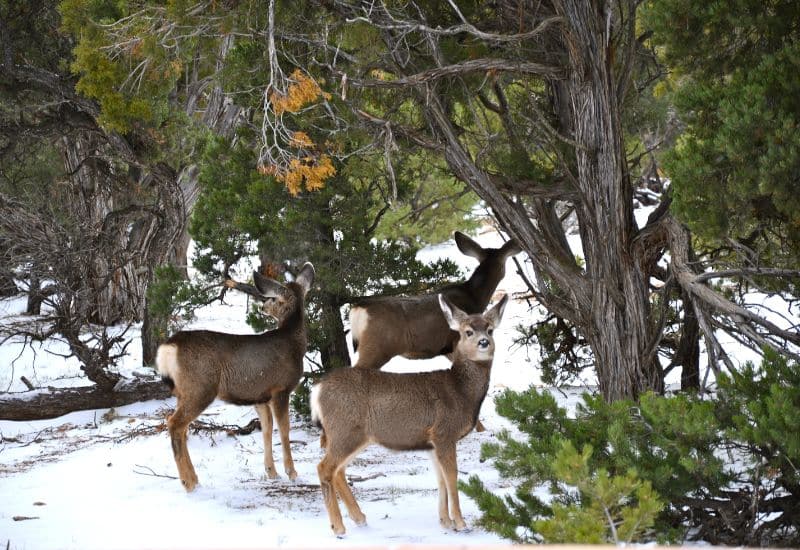
The best spots? Check out areas around the South Rim and along the quieter trails. Early morning or just before dusk are prime times – that’s when animals are most active. Plus, with the winter’s shorter days, you don’t have to wake up ridiculously early for a sunrise wildlife adventure.
Bird enthusiasts, you’re in for a treat too. Winter brings some unique bird species to the canyon. Keep your eyes peeled for bald eagles and the California condor. These majestic birds are easier to spot against the winter sky.
Remember, bring your binoculars and a camera with a good zoom lens. Wildlife can be skittish, so you’ll want to keep your distance while still getting a good view.
So, wrap up warm and get ready for some awesome wildlife watching. The Grand Canyon’s critters in winter are a sight to behold!
Ranger-led Programs
Diving into Ranger-led Programs at the Grand Canyon in winter is a real treat. Here’s the lowdown:
Winter is a special time for these programs because they’re more intimate – fewer visitors mean smaller groups and a more personal experience. Rangers offer a variety of programs, from talks about the canyon’s geology to guided walks where you learn about the local flora and fauna. It’s like a live documentary with the canyon as your backdrop!
What’s really cool is that some rangers specialize in winter ecology. So, you’ll get insights into how the canyon and its inhabitants adapt to the colder months. These programs are not just informative; they’re super engaging.
Most programs are free with park admission, and they vary daily. Check the Visitor Center or the park’s website for the schedule. And here’s a tip: Dress warmly! Some programs might involve standing or walking in chilly weather, so you’ll want to be comfortable.
Joining a Ranger-led program is like unlocking a secret level of understanding the Grand Canyon. It’s educational, it’s fun, and it really adds depth to your visit. So, don’t miss out!
Cross-Country Skiing on the North Rim
Cross-country skiing on the North Rim of the Grand Canyon in winter is an experience like no other. Here’s what you absolutely need to know:
The North Rim turns into a snowy wonderland, making it perfect for cross-country skiing. This isn’t just any ski trip – it’s skiing with some of the most breathtaking views in the world. Imagine gliding over fresh snow with the Grand Canyon as your backdrop!

Trails like the North Kaibab Trail and Ken Patrick Trail are popular choices. The North Kaibab Trail offers a more challenging route with its changes in elevation, while Ken Patrick is great for a more leisurely ski. And here’s a neat fact: The North Rim sits at over 8,000 feet, so you’re really up in the high country!
You’ll need to bring your own gear, as rentals aren’t available on the North Rim. And since the North Rim is closed to vehicle traffic in winter, you’ll have a peaceful, uncrowded experience. Just you, the snow, and the canyon.
Remember, this is high-altitude skiing, so be prepared. Dress in layers, carry water and snacks, and be aware of your limits. Skiing at this elevation can be tiring.
Cross-country skiing on the North Rim is a unique way to experience the Grand Canyon’s quieter side. It’s peaceful, picturesque, and totally invigorating. So, strap on those skis and get ready for an adventure!
Snowshoeing Adventures
Heading out for some snowshoeing in the Grand Canyon this winter? Here’s the nitty-gritty:
Snowshoeing here isn’t just a walk in the park – it’s a walk in a spectacular, snow-covered national park! The Grand Canyon in winter transforms into this serene, white paradise, perfect for snowshoeing.
Now, the place to be is the South Rim. Why? Because it’s open all year round, and the trails are just right for snowshoeing. You’ve got the Rim Trail, for instance, which is relatively flat and stretches for about 12 miles along the canyon’s edge. But hey, you don’t have to do the whole thing – just pick a section and go.
If you’re lucky, you might catch one of those Ranger-led snowshoe hikes. They’re usually about 2 to 3 miles long, and you get to learn all about the canyon’s winter ecology – super cool stuff. But remember, these tours are popular, so hit up the Visitor Center early to snag a spot.
Dress in layers – it can be a chilly 20-40 degrees Fahrenheit out there, but you’ll warm up fast once you start moving. And don’t forget water and snacks. Even in the cold, staying hydrated is key, especially at elevations reaching 7,000 feet.
Snowshoeing in the Grand Canyon is a blast. It’s a chance to see the park in a whole new light – quieter, calmer, and just stunning with all that snow. So, grab those snowshoes and get ready for an unforgettable winter adventure!
Stargazing
Stargazing at the Grand Canyon in winter, my friend, is an out-of-this-world experience. Let me lay down the facts:
Winter skies at the Grand Canyon are crystal clear, offering some of the best stargazing opportunities. Why? Less humidity and minimal air pollution. This means you get a spectacular view of constellations, planets, and meteor showers.
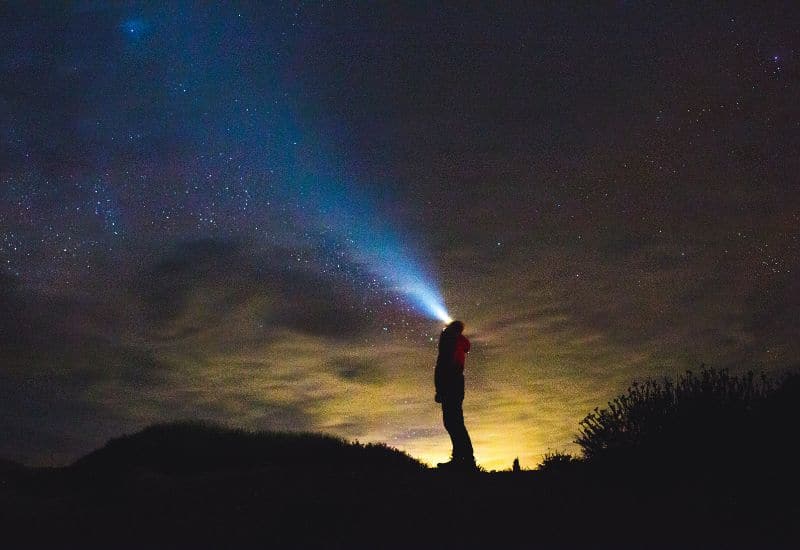
The best part? The South Rim, sitting at an elevation of about 7,000 feet, is open all winter and offers unobstructed views of the cosmos. Imagine this: You, in the crisp winter air, under a vast sky full of stars, with the silhouette of the canyon around you – it’s surreal!
Now, let’s talk timing. Winter nights are longer, giving you more time under the stars. And keep an eye out for special events like the Geminids Meteor Shower in December or the Quadrantids in January. These meteor showers can offer up to 120 meteors per hour on a clear night.
Don’t forget to bundle up! Temperatures can drop below freezing at night, so warm clothes are a must. A thermos with a hot drink wouldn’t hurt either.
Stargazing in the Grand Canyon during winter is a unique experience. It’s not just about seeing stars; it’s about feeling small under that immense night sky, surrounded by one of nature’s greatest creations. So, gear up and get ready for some stellar views!
Helicopter Tours
Alright, let’s talk about helicopter tours over the Grand Canyon in winter – it’s a whole different level of awesome.
First thing’s first: seeing the Grand Canyon from the air in winter is jaw-dropping. Why? Because you get this epic contrast of snowy peaks against the red canyon walls. It’s like seeing the canyon dressed up for a fancy winter gala!
Helicopter tours typically last around 30 to 45 minutes, but you can find longer ones if you’re really looking to splurge. You’ll be soaring over landmarks like the Tower of Ra, Dragon Corridor, and the North Rim, which is usually closed to ground traffic in winter. Imagine gliding over these iconic spots with a bird’s-eye view!
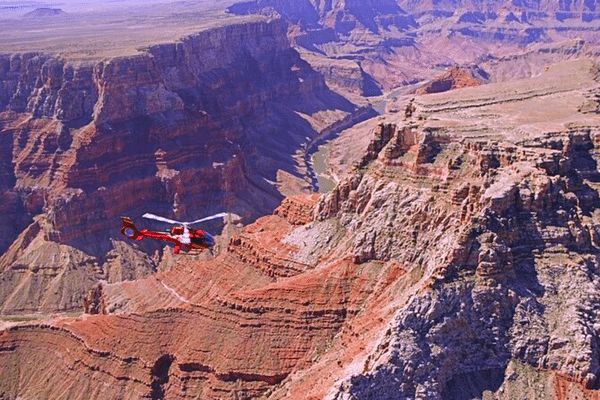
And here’s a cool thing – the winter light is different. The low angle of the sun creates these dramatic shadows and highlights in the canyon, making your photos look like they’re straight out of a magazine.
Just a heads-up, though, winter weather can be unpredictable, so tours might get rescheduled. But don’t worry, most operators are super flexible with this.
Taking a helicopter tour over the Grand Canyon in winter is an unforgettable experience. It’s like unlocking a secret level of the canyon that you just can’t see from the ground. So, if you’re up for a splurge, this is definitely the way to go!
Also Read: 6 TOURS IN THE GRAND CANYON NATIONAL PARK THAT INVOLVE HELICOPTERS!
Mule Rides
Mule rides in the Grand Canyon during winter – now that’s an adventure with a twist!
First up, these mule rides are a classic Grand Canyon experience, but in winter, they’re extra special. Why? Fewer crowds, for starters. And the views, with snow accents on the canyon walls, are simply stunning.
These rides typically last about 2 to 3 hours, and they’re a great way to experience the canyon without the heavy lifting of hiking. You’ll be on a sure-footed mule, which means you can relax and soak in the views while your four-legged friend does the walking.
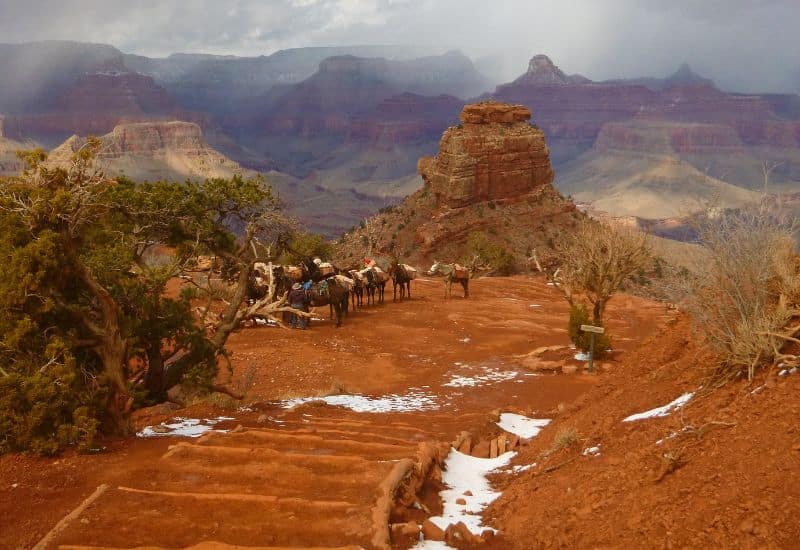
The most popular route for winter is along the Canyon Rim. It’s less strenuous than the descent into the canyon, making it perfect for the chillier weather. Plus, the rim views are unbeatable – you get panoramic vistas of the canyon covered in a dusting of snow.
Just a heads-up: You’ll need to book these rides in advance, as they can fill up fast, even in winter. And remember to dress warmly – it can get pretty cold on the rim, especially when you’re riding.
Mule rides in the Grand Canyon are a unique way to experience the park’s natural beauty. They’re fun, they’re scenic, and they offer a bit of old-world charm you just don’t get anywhere else. So, saddle up and get ready for a memorable ride!
Rock Climbing for Beginners
Rock climbing in the Grand Canyon during winter, especially for beginners, is an exhilarating experience you shouldn’t miss.
First off, winter is a great time for beginners to try rock climbing here. Why? The cooler temperatures make for more comfortable climbing conditions – you won’t be sweating it out under the hot sun.
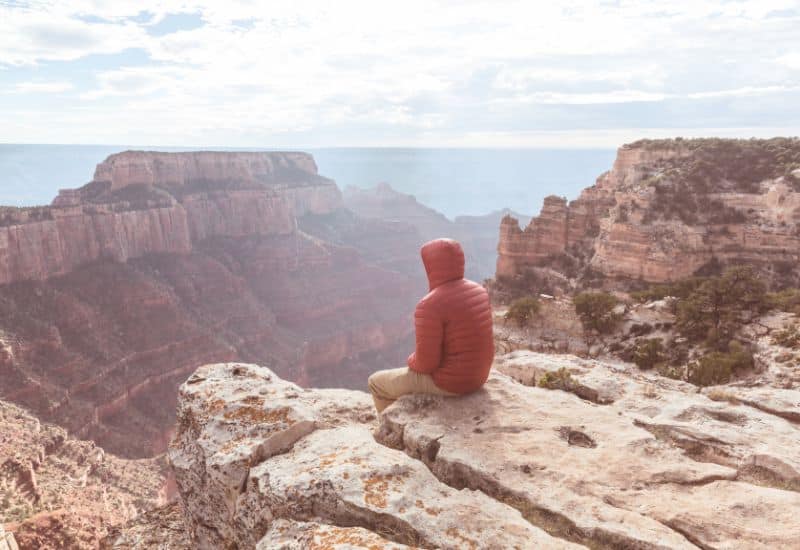
Now, the Grand Canyon isn’t known as a climbing hotspot, but there are definitely some beginner-friendly spots. Areas like the South Rim offer climbs that are perfect for those just starting out. These routes are less about technical difficulty and more about enjoying the climb and the view.
A key detail: you’ll need a permit for rock climbing in the park. It’s not just a formality; it’s about safety and preserving the natural beauty of the canyon. And since winter is off-peak season, getting a permit is usually easier.
As for the climb itself, remember that the Grand Canyon’s elevation is pretty high – the South Rim averages around 7,000 feet. So, take it slow, stay hydrated, and give yourself time to acclimatize.
Rock climbing here in the winter is not just about the physical challenge; it’s about immersing yourself in the grandeur of the canyon. It’s peaceful, the views are different from any other climbing spot in the world, and it’s a great way to start your climbing journey. So, gear up, get that permit, and get ready to scale some rocks!
Camping in the Backcountry
Camping in the Grand Canyon’s backcountry during winter? It’s a unique and unforgettable experience. Let’s dive into the essentials:
First up, winter backcountry camping in the Grand Canyon is for those who love a bit of solitude and adventure. Why? The crowds are way thinner, and the views? They’re a snowy wonderland.
To camp in the backcountry, you’ll need a permit. These are crucial as they help manage the park’s delicate ecosystem. And here’s a key detail: applying for permits in winter is often easier than in peak seasons, but you still want to plan ahead.
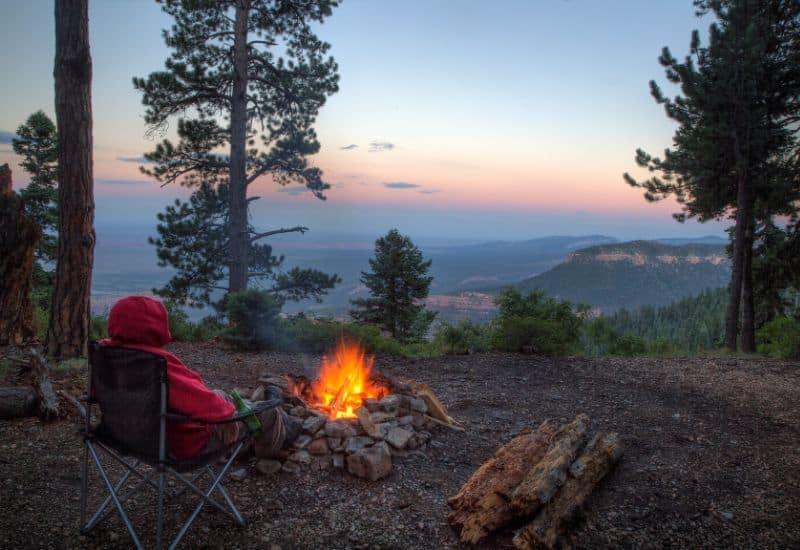
Now, where to camp? Popular backcountry spots like Bright Angel Campground and Indian Garden Campground are less crowded in winter. These spots offer a more serene experience, plus they’re accessible via maintained trails like the Bright Angel and South Kaibab trails.
One major thing: be prepared for cold temperatures. We’re talking potentially below freezing at night. So, a good quality, four-season tent and a sleeping bag rated for cold weather are must-haves. And layers – don’t forget lots of warm, moisture-wicking layers.
And remember, backcountry camping in the Grand Canyon isn’t like your typical campground experience. There’s no running water or warm showers. It’s just you, your gear, and the wilderness.
Winter camping in the Grand Canyon’s backcountry is an adventure that offers peace, beauty, and a sense of accomplishment. Just be sure to plan well, pack right, and leave no trace. Happy camping!
Visit the Grand Canyon Skywalk
Visiting the Grand Canyon Skywalk in winter – now that’s a walk to remember! Let me give you the lowdown:
The Skywalk, this incredible, horseshoe-shaped glass bridge, juts out over the canyon, offering breathtaking views. And in winter? It’s even more special. You’ve got fewer tourists, so you can enjoy the view without the crowds.

Located at Eagle Point on the West Rim, the Skywalk is about 4,000 feet above the canyon floor. Yep, you’re literally walking in the sky! The glass floor provides a unique perspective – looking straight down into the depths of the canyon.
Winter weather here is usually milder than on the North or South Rims. Expect temperatures around 40 to 60 degrees Fahrenheit, which is pretty comfortable for walking and sightseeing.
Remember, no personal belongings, including cameras, are allowed on the Skywalk. But don’t worry, they have professional photographers to capture that moment for you.
Visiting the Grand Canyon Skywalk in winter is an unforgettable experience. It’s serene, majestic, and gives you a view of the canyon like no other. So, step out onto that glass bridge and embrace the thrill!
Historic Village Walking Tour
Taking a Historic Village Walking Tour at the Grand Canyon during winter is like stepping back in time, with a frosty twist!
The historic village on the South Rim is full of amazing sights and stories. In winter, with a blanket of snow and fewer tourists, it feels even more intimate. You’re walking through history in a quiet, snowy setting – it’s pretty magical.
On this tour, you’ll get to see historic buildings like El Tovar Hotel, the Bright Angel Lodge, and the Train Depot. These aren’t just old buildings; they’re pieces of the canyon’s history, each with its own story. El Tovar, for instance, has been around since 1905 and is a classic example of National Park Service rustic architecture.
What’s cool about the walking tour is that you’ll learn about the canyon’s early tourism days and how these buildings played a role. It’s a unique blend of history and stunning natural beauty.
Dress warmly, though! Winter days can be chilly, especially if you’re walking around for a couple of hours. But the crisp air adds to the charm of the experience.
So, a Historic Village Walking Tour in winter is not just educational, it’s a visually stunning journey through the Grand Canyon’s past. It’s a must-do for history buffs and anyone who loves a good winter walk with a view!
Colorado River Rafting
Rafting the Colorado River through the Grand Canyon in winter? That’s an epic adventure with a chilly but thrilling twist!
First thing’s first: winter rafting on the Colorado River is a unique experience. The river’s mighty rapids paired with the canyon’s snow-dusted cliffs? Absolutely breathtaking.
Now, winter rafting trips are usually shorter, think 1 to 5 days. They’re perfect if you want the thrill without a week-long commitment. The temperatures? Well, they can be pretty cool, averaging between 40 and 60 degrees Fahrenheit during the day. But don’t worry, the physical activity keeps you warm, and the chill adds to the adventure.
One of the coolest things about winter rafting is the tranquility. The summer crowds are gone, so it’s just you, the river, and the grandeur of the canyon. It’s a more intimate experience with nature.
Make sure to pack waterproof gear and layers to stay warm and dry. And yes, the water can be cold, but most outfitters provide wetsuits or drysuits to keep you comfortable.
Rafting the Colorado River in winter is an exhilarating way to experience the Grand Canyon’s raw beauty. It’s adventurous, peaceful, and a totally different perspective on this natural wonder. So, if you’re up for a chilly but awesome adventure, winter rafting is the way to go!
Attend a Cultural Demonstration
Attending a cultural demonstration at the Grand Canyon in winter is an enriching and enlightening experience. Here’s what makes it special:
During winter, the Grand Canyon hosts a variety of cultural demonstrations, especially at the South Rim Visitor Center. These demonstrations are a fantastic way to learn about the rich histories and cultures of the Native American tribes associated with the canyon.
You’ll get to see things like traditional weaving, pottery making, and storytelling. These aren’t just displays; they’re interactive experiences where you can engage with the artisans and learn about the significance of their crafts and traditions.
What’s really great about attending these in winter is the cozy, intimate atmosphere. The smaller crowds mean you get a more personal experience, a chance to really connect and understand the cultural significance of the Grand Canyon.
Remember, these demonstrations vary, so check the park’s schedule. They’re usually free with park admission, which is a bonus.
Attending a cultural demonstration at the Grand Canyon in winter isn’t just about watching; it’s about immersing yourself in the living history and culture of this incredible place. It’s educational, inspiring, and a great way to deepen your connection to the canyon. So, don’t miss out on this unique opportunity!
Explore the Kolb Studio
Exploring the Kolb Studio at the Grand Canyon in winter offers a serene and insightful experience. This historic building, once the home and studio of the pioneering Kolb brothers, sits on the edge of the South Rim and serves as a unique window into the early days of Grand Canyon photography.
The studio houses an exhibition space, showcasing the photographic legacy of the Kolb brothers. Their work captures the early adventurous spirit of the canyon, offering a glimpse into the past. It’s a fascinating look at how the Grand Canyon was first photographed and explored.
What adds to the experience is the setting. The studio, during winter, is less crowded, allowing for a more contemplative visit. And the views from the studio are breathtaking, offering a panoramic perspective of the snow-dusted canyon.
Visiting the Kolb Studio in winter combines a touch of history with stunning natural scenery. It’s an opportunity to appreciate the canyon’s past, framed by its spectacular winter beauty. Don’t miss this unique blend of art and nature at the Grand Canyon.
Winter Bird Watching
Winter bird watching at the Grand Canyon is a surprisingly vibrant activity, offering a peaceful yet exciting experience.
In the winter months, the Grand Canyon becomes a haven for various bird species, making it an ideal time for bird enthusiasts. The South Rim, remaining open all year, is particularly great for spotting birds against the stark contrast of the snowy landscape.
Notably, you’ll have the chance to see species like bald eagles and the California condor, among others. These majestic birds are more visible against the winter sky and provide exceptional bird watching opportunities. The cooler temperatures also mean fewer crowds, allowing for a more tranquil birding experience.
Dress warmly, as temperatures can be quite brisk, and bring binoculars for the best views. Bird watching here isn’t just about the birds; it’s about enjoying the quiet beauty of the canyon in winter.
Winter bird watching at the Grand Canyon is a unique way to connect with nature and witness the park’s wildlife in a serene, snowy setting. It’s a must-do for bird lovers and anyone looking to experience the canyon’s quieter side.
Havasupai Waterfalls Hike
Hiking to the Havasupai Waterfalls in the Grand Canyon during winter offers a distinct and serene experience. Although more challenging in the colder months, the reward is a unique view of these stunning waterfalls amidst a quieter and more peaceful canyon.
The Havasupai Waterfalls, known for their breathtaking turquoise waters, are located in a remote section of the Grand Canyon, within the Havasupai Indian Reservation. The main hike to the waterfalls, starting from Hualapai Hilltop, is about 8 miles to the village of Supai, and then an additional 2 miles to the famous Havasu Falls.
Winter conditions can make the trail more challenging, so it’s essential to be well-prepared with appropriate gear, including waterproof and warm clothing. The cooler temperatures also mean the water might be too cold for swimming, but the sight of the waterfalls, possibly with a touch of ice, is extraordinary.
It’s important to remember that visiting the Havasupai waterfalls requires a permit from the Havasupai Tribe. These permits can be hard to come by, so plan and book well in advance.
Hiking to the Havasupai Waterfalls in winter is an adventure for those looking for a less-traveled path and a chance to see these natural wonders in a unique light. It’s a demanding hike but offers a rewarding and tranquil experience amidst the stunning backdrop of the Grand Canyon.
Sunrise and Sunset Watching
Sunrise and sunset watching at the Grand Canyon in winter is an experience that truly captures the majestic beauty of this natural wonder.
In winter, the air is typically clearer, allowing for more vivid sunrise and sunset views. The interplay of light and shadow over the snow-covered canyon creates a breathtaking palette of colors.
Sunrise offers a peaceful start to the day, with soft hues illuminating the canyon’s depths. Sunset, on the other hand, bathes the canyon in warm, glowing colors, creating a dramatic and unforgettable spectacle.
Some of the best spots for these views are Mather Point, Yavapai Observation Station, and Hopi Point on the South Rim. Mather Point is easily accessible and provides a panoramic view of the canyon at sunrise.
Yavapai Observation Station offers a broad perspective, ideal for both sunrise and sunset. Hopi Point, known for its wide views, is particularly famous for sunset watching.
Remember, winter days can be cold, especially during these early and late hours, so dress warmly. Arriving early for sunrise and staying a bit after sunset allows you to fully appreciate the changing colors and moods of the canyon.
Sunrise and sunset watching in the Grand Canyon during winter is not just a visual experience; it’s a moment to connect with nature’s grandeur in a quiet, introspective setting. It’s a must-do for any visitor looking to experience the canyon’s beauty in its most ethereal form.
Participate in a Photography Workshop
Participating in a photography workshop at the Grand Canyon during winter offers a unique opportunity to capture its stunning landscapes.
With the guidance of professional photographers, you’ll learn techniques suited for the winter scenery, like long exposure and landscape composition. Workshops vary in length, allowing for in-depth exploration of the canyon’s best photo spots.
Winter conditions bring clearer skies and softer light, ideal for photography. Smaller group sizes mean more personalized instruction. Just remember to bring your camera gear and dress warmly, as you’ll be outdoors.
A photography workshop in the Grand Canyon’s winter wonderland is not just educational; it’s an opportunity to create breathtaking images in a serene, majestic setting.
Also Read
17 STOPS ON AN EPIC LOS ANGELES TO GRAND CANYON NATIONAL PARK ROAD TRIP! (ITINERARY INCLUDED)
6-DAY ULTIMATE HIKING TRIP FROM LAS VEGAS! (GRAND CANYON AND ZION INCLUDED)
FAQs about Visiting the Grand Canyon in Winter
1. What are the typical weather conditions in the Grand Canyon during winter?
- Answer: Winter in the Grand Canyon can be quite cold, especially at higher elevations. Expect temperatures ranging from below freezing to about 40-50 degrees Fahrenheit. Snow is common on the North Rim and at higher elevations on the South Rim.
2. Is the Grand Canyon open all year round, including the winter months?
- Answer: Yes, the Grand Canyon is open year-round. However, the North Rim is usually closed to vehicle traffic from the first heavy snow in November/December until May 15th due to snow. The South Rim and the West Rim, including the Skywalk, are open throughout the winter.
3. Are there any special activities or tours available only in winter?
- Answer: Winter offers unique activities like snowshoeing and cross-country skiing on the North Rim. Also, ranger-led programs and cultural demonstrations are often less crowded and more intimate during this season.
4. What should I pack for a winter visit to the Grand Canyon?
- Answer: Dress in layers to adapt to changing temperatures. Essential items include a warm jacket, gloves, a hat, waterproof boots for snow, sunscreen, and plenty of water. If you’re planning on hiking, consider traction devices for your shoes, as trails can be icy.
5. Are the park facilities and accommodations open during winter?
- Answer: Many facilities on the South Rim, including hotels, restaurants, and visitor centers, remain open in winter. However, services on the North Rim are limited due to the seasonal closure.
6. Is winter a good time for photography at the Grand Canyon?
- Answer: Absolutely! Winter offers clearer skies and a unique lighting that is ideal for photography. The contrast of snow against the canyon walls provides a breathtaking backdrop for photographers.
7. Can I still go hiking in the Grand Canyon during winter?
- Answer: Yes, hiking is possible in winter, especially on the South Rim. Trails may be icy or snowy, so it’s important to be prepared with appropriate gear and check trail conditions before heading out.
8. Is it necessary to make reservations for accommodations or tours in advance during winter?
- Answer: While winter is less crowded, it’s still recommended to book accommodations and any special tours, like helicopter rides or photography workshops, in advance to ensure availability.

